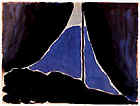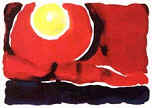|

"My first memory is of the brightness of
light...light all around. I was sitting among pillows on a
quilt on the ground...very large white pillows..."
Georgia Totto O'Keeffe was born in a farmhouse on a
large dairy farm outside of Sun Prairie, Wisconsin on
November 15, 1887.
Education for women was a family tradition. Georgia's own
mother, Ida had been educated in the East. All the
daughters but one became professional women, attesting to
her influence on them.
When Georgia was in the eighth grade she asked a
daughter of a farm employee what she was going to do when
she grew up. The girl said she didn't know. Georgia
replied very definitely...
"...I am going to be an
artist!"--"I don't really know where I got my
artist idea...I only know that by that time it was
definitely settled in my mind."
In 1902 her parents moved to Virginia and were joined
by the children in 1903. By the age of 16 Georgia had 5
years of private art lessons at various schools in
Wisconsin and Virginia.
One particular teacher, Elizabeth Willis encouraged her to
work at her own pace and afforded her opportunities that
the other students felt unfair. At times she would work
intensely, and at other times she would not work for days.
When it was brought to the attention of the principal, she
would reply..."When the spirit moves Georgia, she can
do more in a day than you can do in a week"
After receiving her diploma in 1905 she for left
Chicago to live with an aunt and attend the Art Institute
of Chicago. She did not return to the Institute the
following year after a bout with Typhoid Fever. Instead,
in 1907 she enrolled at the Art Student League in New York
City.
While at the Art Student League, Eugene Speicher, a
student at the League asked Georgia to pose for him.
Seeing her annoyance at the offer he commented, "It
doesn't matter what you do, I'm going to be a great
painter and you will probably end up teaching painting in
some girls' school." She latter agreed to pose for
him. The image at the top of this page was painted by
Speicher in 1908.
Discouraged with her work, she did not return to the
League in the fall of 1908, but moved to Chicago and found
work as a commercial artist. During this period Georgia
did not pick up a brush, and said that the smell of
turpentine made her sick.
She moved back to her family in Williamsburg, Virginia
in 1909 and later enrolled at a nearby college. In 1912 a
friend in Texas wrote that a teaching position was open in
Amarillo, Texas for a "drawing supervisor".
Georgia applied for the position and was hired for the
fall semester. She would remain here till 1914, making
trips to Virginia in the summer months to teach at the
University of Virginia.
After resigning her job in Amarillo, Georgia moved to
New York City to attend Columbia Teachers College until
accepting a teaching position at Columbia College in South
Carolina. Having a light schedule, she felt it would be an
ideal position that would give her time to paint. Here she
was to strip away what she had been taught to paint and
began to paint as she felt.
"I have things in my head that are not like
what anyone has taught me...shapes and ideas so near to
me...so natural to my way of being and thinking that it
hasn't occurred to me to put them down..."
Early in 1916, Anita Pollitzer took some of Georgia's
drawings to Alfred Stieglitz's 291 gallery. He was to
exclaim, "At last, a woman on paper!". He told
Anita the drawings were the "purest, finest,
sincerest things that had entered 291 in a long
while.", and that he would like to show them. Georgia
had first visited 291 in 1908, and later on several
occasions, but had never talked with Stieglitz...although
she had high regard for his opinions as a critic.
 "I
believe I would rather have Stieglitz like
something...anything I had done...than anyone else I know
of..." "I
believe I would rather have Stieglitz like
something...anything I had done...than anyone else I know
of..."
In April Stieglitz exhibited 10 of her drawings. She
had not been consulted before the exhibit and only learned
about it through an acquaintance. She confronted Stieglitz
for the first time over the drawings...later agreeing to
let them hang.
Needing a job, and missing the wide, flat spaces of
northern Texas, Georgia accepted a teaching job at West
Texas State Normal College in the fall of 1916.
She would often make trips to the nearby Palo Duro Canyon,
hiking down the steep slopes to observe the sandstone
formations with white gypsum, and orange mudstone above
the rich green canyon floor. At least 50 watercolors were
painted during the time spent in Canyon, Texas.
"It was all so far away...there was quiet
and an untouched feel to the country and I could work as I
pleased."
 Georgia's
first solo show opened at 291 in April 1917. Most of the
exhibit were the watercolors from Texas. After the show
Stieglitz decided to close 291 due to financial
difficulties but said, "Well I'm through...but I have
given the world a woman." Georgia's
first solo show opened at 291 in April 1917. Most of the
exhibit were the watercolors from Texas. After the show
Stieglitz decided to close 291 due to financial
difficulties but said, "Well I'm through...but I have
given the world a woman."
During the winter Georgia became ill with the flu that was
sweeping the country. She took a leave of absence from the
teaching job and later resigned. It's possible that there
was pressure from the community to encourage her
resignation, as she had what was considered radical views
about the United States entry into the war in
Europe...along with other non-mainstream opinions shocking
this small Texas town.
She was encouraged by Stieglitz to return to New York. By
this time he had fallen in love with Georgia and wanted to
pursue a relationship. He being in an unhappy marriage,
had moved out from the family home and into his studio.
She boarded a train in June of 1918 to return to New York
and Stieglitz...and to a new life that would make her into
one of the most important artist of the century.
Recopilado por Gabriel Gross
|